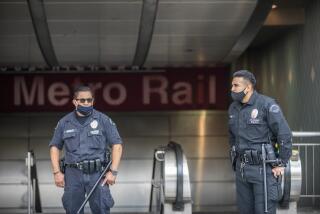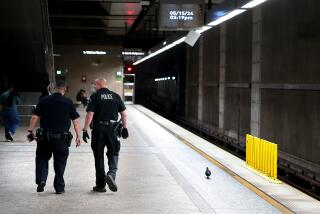So many rail agencies, so little service
The Times deserves credit for bringing attention to rail safety with its Sept. 27 article, âDeath on the rails in L.A.â But the article focused too much on the sensational and not enough on the root causes of Metrolinkâs safety problems. For example, I agree that the rail crossing in Burbank at the Buena Vista Street and San Fernando Road intersection, which The Times cited as a particularly dangerous crossing, needs to be grade separated. But because plans are already underway to do just that, why pick on that location when, judging by the graphic attached to the article, there are more problematic crossings in Anaheim, Corona and other communities?
The Times did not go into enough detail about the organizational problems plaguing Metrolink in particular and Southern California rail service as a whole. It failed to highlight the fact that we have three taxpayer-funded agencies providing âmainlineâ passenger train service in Southern California (Amtrak, Metrolink and San Diego Countyâs Coaster). Nor did it make clear that the rights of way are owned either by individual county transportation agencies or private railroads such as BNSF and Union Pacific. Metrolink is little more than an operating agency beholden to the counties that formed it, and a stepchild when it comes to funding. If there is blame to be attached for safety lapses, there are plenty of targets, not just Metrolink.
In addition to divided responsibility for safety issues, this âstructureâ results in the complete failure to provide Southern California residents with a viable, user-friendly alternative to the automobile. Schedules arenât coordinated for seamless journeys around the region. Indeed, Metrolink cannot even provide good connections between its own routes. Such is the lack of cooperation that every day a southbound Amtrak train from San Luis Obispo must wait in Moorpark for more than 30 minutes for northbound Metrolink trains to pass. This is especially ironic as the chairman of Metrolinkâs board is a City Council member from Moorpark.
Even combining the regional services of Amtrak, Metrolink and the San Diego County systems would yield a boutique operation, amounting to fewer than 300 trains per day serving 83 stations in eight counties with a combined population of more than 20 million. I estimate that these systems serve between 15 million and 18 million passengers per year. By contrast, Switzerland (which is similar in size to the Southern California area served by passenger rail) has about 7.7 million residents who are served by roughly 2,000 miles of railroad and more than 800 stations. The Swiss operation offers passengers a unified timetable and ticketing system that provides through journeys and connections between almost any two points in the country. Imagine buying a through ticket from Santa Clarita to Catalina Island with guaranteed connections by train, light rail and ferry. The Swiss and their visitors made more than 350 million train journeys in 2008.
The Swiss did not build this system up overnight, nor was it inexpensive. But had Southern California embarked on such a plan when Metrolink began operations in 1992, we would have a much better system -- even if we were running no more trains or had no more stations than we do now. Without connections, the destination options for passengers are limited to the stations on their line.
What we have instead is a lack of vision and leadership. For years, the lead planning agency in the area, the Southern California Assn. of Governments, was mesmerized by completely unaffordable Maglev technology. Metrolink and Amtrak were barely considered in its transportation plans even though we had miles of existing rights of way that could have been exploited and improved.
Perhaps these conventional rail systems would get more attention if they were ultra-expensive. Or perhaps the issue is that Metrolink receives most of its funding from other transportation commissions, such as the Los Angeles County Metropolitan Transportation Authority, that must each give up some of their money to fund this regional system. I donât have the answer, but as a taxpayer, I am paying for trains that donât connect and for bureaucrats that donât cooperate well with each other.
It isnât too late for us to make the necessary changes that will give us a user-friendly public transportation system. A unified passenger rail authority for Southern California would be a good start; it could quickly put out a single schedule and introduce a ticketing system that would accommodate connections. It could also speak with a single, loud voice on safety to ensure that the dangerous locations cited by The Times are given immediate attention.
Over the years, voters have approved taxes and bonds with the hope of enjoying a safe and convenient passenger rail system, but they have been badly let down by these multiple agencies. Itâs time for these âBerlin Wallsâ to come down. Itâs time we got some value for our money.
Paul Dyson is president of the Rail Passengers Assn. of California and Nevada (railpac.org) and chairman of Burbankâs Transportation Commission.
More to Read
A cure for the common opinion
Get thought-provoking perspectives with our weekly newsletter.
You may occasionally receive promotional content from the Los Angeles Times.










